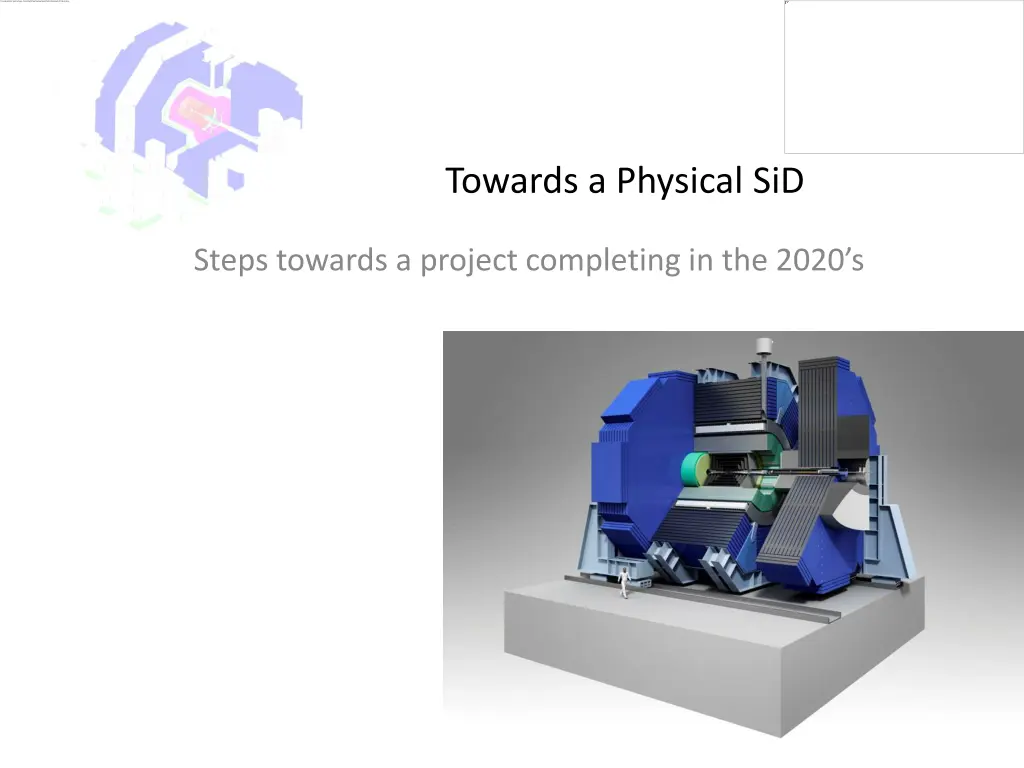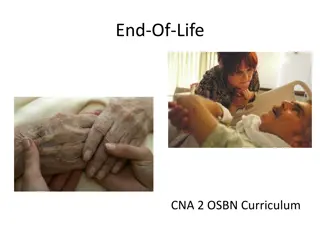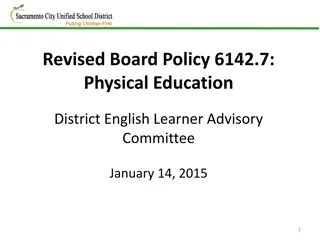
Achieving Project Completion: Steps Towards a Physical SiD
Explore the journey towards completing a project in the 2020s, detailing the steps involving commitments, optimization, collaboration formation, and critical mechanical engineering issues for the SiD. Collaboration, optimization, and timeline management are key aspects discussed in this informative content.
Download Presentation

Please find below an Image/Link to download the presentation.
The content on the website is provided AS IS for your information and personal use only. It may not be sold, licensed, or shared on other websites without obtaining consent from the author. If you encounter any issues during the download, it is possible that the publisher has removed the file from their server.
You are allowed to download the files provided on this website for personal or commercial use, subject to the condition that they are used lawfully. All files are the property of their respective owners.
The content on the website is provided AS IS for your information and personal use only. It may not be sold, licensed, or shared on other websites without obtaining consent from the author.
E N D
Presentation Transcript
Towards a Physical SiD Steps towards a project completing in the 2020 s
Steps toward SiD Some national body (ies) (Japan and collaborators?) commits to linear collider 2013 Optimize SiD (Only crude optimization for LOI; ~0 for DBD!) Can we lower costs and preserve performance? Prepare serious TDR with technical prototypes and serious cost estimate. 3 years: 2016 Requires a fully reviewed TDR. Assume the review process, with minor iterations, takes 1 year. 2017 Procurement, fabrication, and assembly: 6 years 2023 Begin Commissioning But SiD is still a concept, not a collaboration. We will need technically a collaboration of ~500 people. They will have to develop an understanding of all the issues, optimize SiD, and buy into a design. This will also take time. SiD Collaboration Meeting M. Breidenbach 2
Technically Limited Timeline Adding collaboration formation Some overlap of major tasks possible SiD Collaboration Meeting M. Breidenbach 3
From here to Commitment The DBD does not demonstrate significant technical progress since the LOI except for Benchmarking. At least the calorimeters need optimization: thicknesses, layer structure, and aspect ratio. ~1-2 physicist years. A Technical Design Report should include: Clear baseline choices for all subsystems Final subsystem dimensions & clearances Reasonably complete mechanical designs including tooling Prototypes and beamtests Serious cost estimate We presently have < 0.5 Mechanical Engineers total in SiD. This would have to go to 2 FTE s to begin to make mechanical progress. In the intensive TDR stage, this should be ~10 FTE s + similar number of designers. The Electronic Engineering is in better shape. System Engineering (Interfaces) needs serious effort, particularly cryogenics interfaces . Japanese codes (e.g. radiation, B fields, seismic, transport, etc) need to be studied. Need to encourage US-Japan collaboration proposal. SiD Collaboration Meeting M. Breidenbach 4
Critical Issues for Mechanical Engineering 1. The SiD Solenoid: Iron structure and supercoil have a pre-conceptual design. R&D is ~stalled on interesting aspects such as better superconductors and stabilizers. Japanese mountain sites require iron engineering & optimization study of segmentation for: Transport Assembly including handling fixtures Integration of muon system on surface The integrated dipole seems difficult. ILC should confirm there is no beamline optics solution. The design can not progress beyond this until the inner radius and length of the solenoid is settled. This requires optimization of the solenoid. This is not an engineering choice, but a physics and cost issue. The Exoskeleton should be revisited. Is it needed? 5 June 2010 M. Breidenbach 5
Critical Issues for Mechanical Engineering 2. Machine Detector Interface There is ~1.5 m radial difference between SiD and ILD. The SiD platform is 3.8 m thick. The platforms appear to add a year to the construction schedule. Revisit platforms?? SiD L* = 3.5 m; ILD L* = 4.5 m. BNL design dimensions for the SiD QD0 are needed. Support and vibration issues need continued work. SiD needs seismic study. 5 June 2010 M. Breidenbach 6
Critical Issues for Mechanical Engineering 3. Mechanical Engineering is in short supply Fermilab is reducing its commitment to SiD. SLAC is down to <1 FTE Annecy and Argonne are occasionally seen at the engineering meetings for some HCal effort. 5 June 2010 M. Breidenbach 7
Critical Issues for Mechanical Engineering 4. It is believed within the engineering group that while there are plenty of other difficult problems to work on, they do not have the impact or logjam effect of optimization. There is an enhanced effort on MDI issues at SLAC. We will try to focus them on Critical Issue 2 Support of the detector, quads, and vibrations and costs. 5 June 2010 M. Breidenbach 8
Engineering Detector Subsystems Beamline: Adequate conceptual design. Impedance issues that can generate wakefields and heating have been checked. Synchrotron radiation issues seem ok. Vacuum design seems ok. Vertex Detector: Minimal conceptual design for modeling. Little ongoing work on support structures, power and cooling, which may make the modeling of multiple scattering and dead regions somewhat optimistic. Tracker: Adequate conceptual design for modeling. Conceptual design for support mechanics. Need to understand Lorentz force issues from pulsed power and cable design. EMCal: Adequate conceptual design for modeling. (But may not be optimized; CLIC work suggests 20 layers adequate for PFA) Mechanical prototyping of structure using relatively small tungsten sheets has stalled. First trials indicate some problems bump bonding KPiX. (Work active for beamtest) Need work on assembly strategy. Current estimate is extremely labor intensive. Robotics? 5 June 2010 M. Breidenbach 9
Engineering Detector Subsystems HCal: No settled conceptual design. Active efforts in PFA work. Critically need outer dimensions of barrel and endcap for solenoid and iron engineering. Radial cracks between modules are apparently accepted, documentation may be weak. The actual detector choice is secondary to the mechanical engineering issues as long as it fits in the allocated space. Cost may well be an issue. Solenoid: In principle CMS approach is ok. Might be significant cost improvements with advanced conductor R&D. Muon System: SiD has changed baseline to scintillator. Conceptual design probably stalled waiting iron segmentation design. Need conceptual design for SiPM readout. BeamCal: Minor mechanical engineering issues. Needs sensor development! 5 June 2010 M. Breidenbach 10
Critical Issues for Metrology The SiD push-pull concept relies on a design that minimizes stresses on (primarily) the tracker and vertex systems so that there is little relative motion, and a metrology system able to measure any motion to the required precision needed to avoid beam based re-calibration. The key technology is a Frequency Scanning Interferometer (FSI) able to make absolute measurements of about a meter to an accuracy of ~ 1 micrometer in air between a fiber optic launcher and a corner reflector. This work was not initially supported by DOE, but now may be. Progress is too slow for a critical component of SiD. In addition there are higher precision systems contemplated for locating the QD0 s (Mona Lisa, etc). Since the FSI s should be able to locate the quads well enough for Beam Based Alignment to work, the case is not as strong as for the FSI s. 5 June 2010 M. Breidenbach 11
Critical Issues for Electronic Engineering None! Issues for Electrical Engineering (excluding sensors): Continue evolution of KPiX, including consideration of time structure of warm machines. Continue evolution of Beam Calorimeter readout chip. Support prototype work, including readout planes for gas detectors. Evaluate concepts for front end powering, e.g. DC-DC conversion. Defer: Continued design of DAQ. Existing ATCA RCE conceptual design is adequate, will profit by delay. This assumes uniform architectures of the front end systems (except for the vertex detector). Note that SiD will not have a hardware trigger. (A warm machine may need consideration of a trigger) 5 June 2010 M. Breidenbach 12
Integration Issues MDI issues are real, but are believed workable. The Self Shielding concept has had another round of Fluka testing, and appears to be conservative. There are schemes for hinged Pacmen to work with both detectors. The vertex detector is being treated as a moderate integration issue. The beampipe conceptual design accommodates the SiD vertex detector design, and appropriate space within the tracker volume is allocated. Details can be worked out once a sensor strategy is selected. This could be quite late. 5 June 2010 M. Breidenbach 13
Detector Strategic Work Review and document: Radiation shielding properties of SiD. Magnetic field leakage Identify any orientation issues for power transformers, motors, etc. Seismic Japan has very significant seismic activity. Understand interplay of platform, detector, and beamline. Japanese codes? Detector Alignment procedures: How will initial assembly alignment be done? Conceptual design of FSI networks. Internal detector services Space assignments for electronics, power conversion Preliminary cable routing Develop better understanding of interfaces and Treaty points with ILC. SiD Collaboration Meeting M. Breidenbach 14
20 R.L. Cu target in IP-14 m. Large pacman. 9 MW Sv/1_train Dose limits Maximum dose - The maximum integrated dose per event is ~8 Sv << 30 mSv - The corresponding peak dose rate is ~140 mSv/h < 250 mSv/h 5 June 2010 M. Breidenbach MSL - SLAC 15 15
Integration Issues The tracker and EMCal baseline approach is to use KPiX chips with local connections to Primary Concentrators which will transition to optical signal transmission and handle low voltage power distribution. There is no genuinely accepted solution for the HCal sensor and readout scheme. This is a cost and DAQ event building/filtering issue. The service penetration requirements for SiD have had a first look, and seem quite modest. Another study will be needed when the magnet end door concept settles down. 5 June 2010 M. Breidenbach 16
Cost There has been a heroic effort by ILC over the past few years to reduce costs, resulting nominally in SB2009 . There has been no corresponding effort by SiD. Historically there was a strong effort to keep a cost cap, but that evaporated in the push for the LO I. There was an explicit effort to optimize the detector using Mark Thompson s parameterization of PFA performance vs Rtrkr, B, and Hcal against the SiD parametric cost model. However, there was no cost cap. This was crude! There has been no subsequent optimization. In ILC costing, the answer is: LOI M&S Base $238M M&S Contingency $88M Engineering Labor 206 MY Technical Labor 613 MY Administrative Labor 25 MY DBD $309M $116M 187 MY 553 MY 30 MY 5 June 2010 M. Breidenbach 17
Costs Is this Reasonable? In US accounting, assuming we start construction in 2017; 3.5% inflation; and DOE National Laboratory labor rates, this corresponds to $877M. Is this reasonable and rational going forward particularly in view of the cost consciousness of ILC? Will there be (more) pressure to move to a single detector? If so, are we better off being a bit more modest? We need a mechanism to make some rational decisions Will this be a LCO issue? 5 June 2010 M. Breidenbach 18
Costs Are they right? To a reasonable extent, there are two semi-disjoint exercises in generating the SiD cost estimate: Calculating quantities of a material or service e.g. how many tonnes of iron. Estimating unit costs e.g. how much does a tonne of machined, painted, QC ed, delivered iron cost. The quantity calculations have been done largely by one person. They need to be checked. Each review has found errors. There is no rational reason to believe all have been found! The unit costs have been studied and agreed upon between SiD and ILD. This does not make them correct!! The sensitivities to unit costs for the major items are indicated in the following by showing the effect of doubling the assumed unit cost: 5 June 2010 M. Breidenbach 19
Unit Cost Sensitivity Item Nominal Unit Cost SiD Base M&S Cost (M$) Magnet Iron (finished and delivered) $6/Kg 48 Tungsten (powder alloy) plate $180/Kg 14 $6/cm2 Si Detector 79 $12000/m2 Hcal Detector (sensor) 42 There may be little basis to adjusting these numbers to be correct but there seems to real value in both detectors using the same values 5 June 2010 M. Breidenbach 20
Conclusions There are technical and philosophical issues that must be resolved before significant forward progress on SiD: Detector (but particularly calorimeter) optimization HCal sensor & readout decisions What do we do (if anything) about the SiD cost? 5 June 2010 M. Breidenbach 21






















